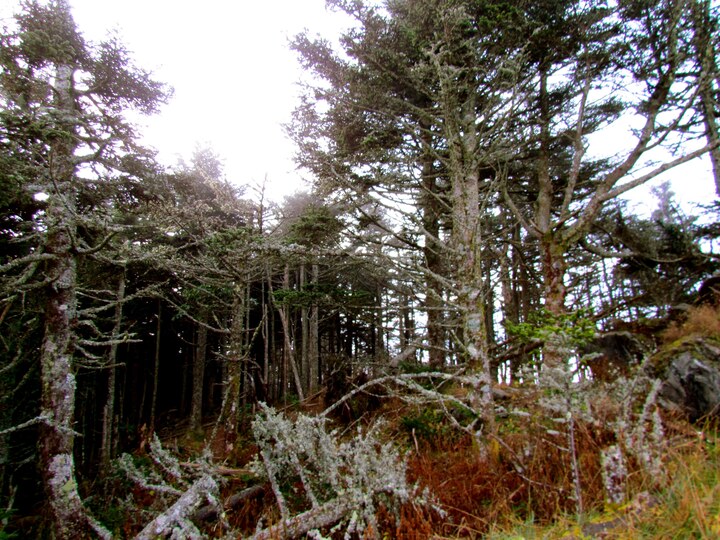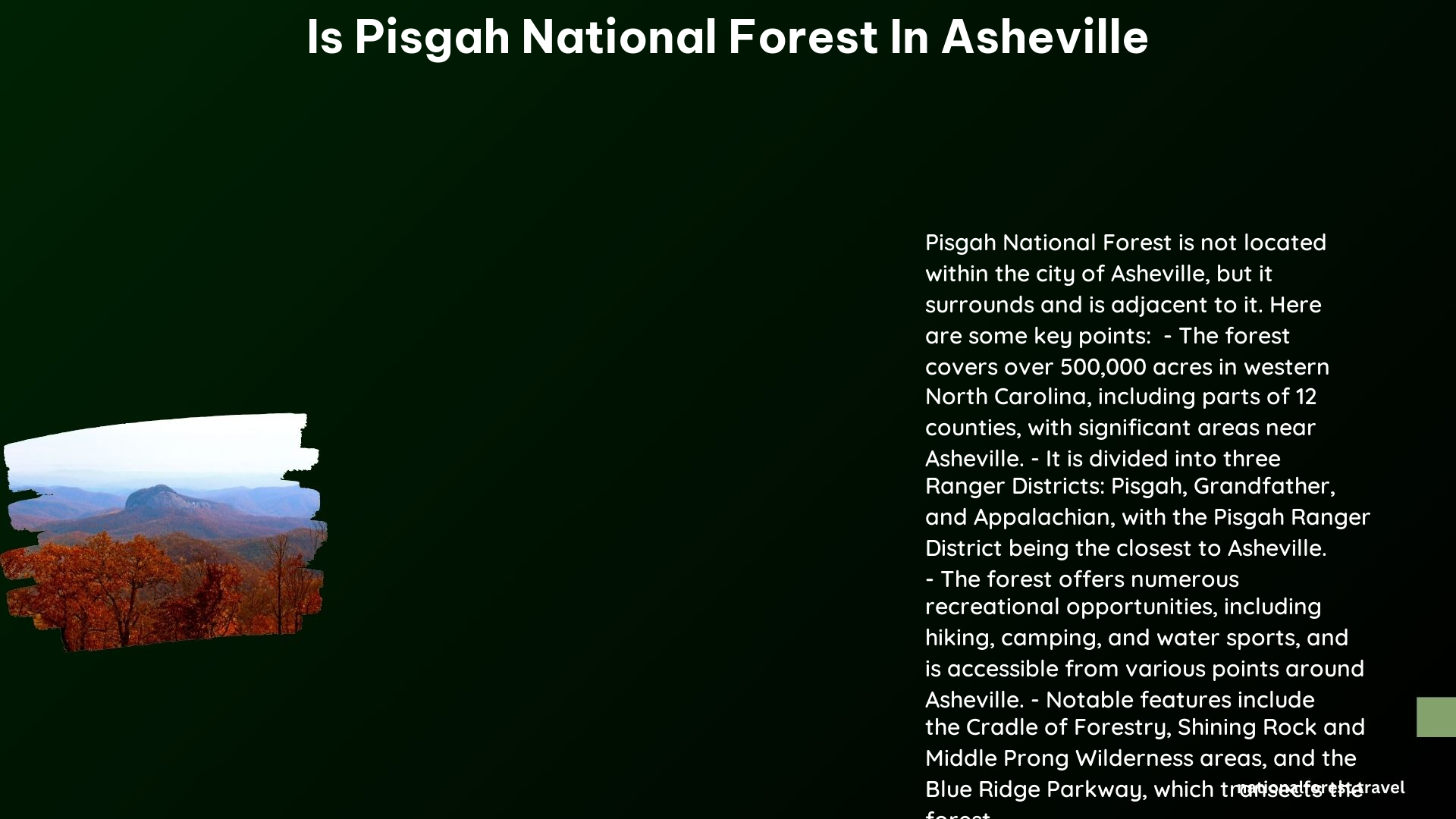Pisgah National Forest is not located within Asheville city limits, but it is a nearby natural treasure. Situated southwest of Asheville, this expansive forest spans multiple counties in western North Carolina. While not in Asheville proper, Pisgah National Forest is easily accessible from the city, offering visitors a wealth of outdoor recreational opportunities and breathtaking natural scenery just a short drive away.
Where is Pisgah National Forest Located in Relation to Asheville?

Pisgah National Forest is located southwest of Asheville, North Carolina. Here are the key details about its location:
- Coordinates: Approximately 35.3600° N latitude and 82.7930° W longitude
- Counties: Spans across Transylvania, Haywood, Buncombe, and Henderson counties
- Distance from Asheville: About 30-40 miles to the Pisgah Ranger District, a common entry point
- Travel Time: Typically 45-60 minutes from Asheville, depending on the route and traffic
The forest’s proximity to Asheville makes it a popular destination for both locals and tourists seeking outdoor adventures and natural beauty.
How Far is Pisgah National Forest from Asheville?

The distance between Asheville and Pisgah National Forest varies depending on the specific destination within the forest. Here’s a breakdown of the distance and travel time:
| Aspect | Details |
|---|---|
| Distance | 30-40 miles (to Pisgah Ranger District) |
| Travel Time | 45-60 minutes |
| Route Options | Direct route via US-74 W and US-276 S |
| Scenic route via Blue Ridge Parkway |
It’s important to note that the travel time can be affected by factors such as traffic, weather conditions, and the specific area of the forest you’re visiting.
What are the Best Routes to Reach Pisgah National Forest from Asheville?
There are several routes to reach Pisgah National Forest from Asheville, each offering its own advantages:
- Direct Route:
- Take I-40 W to US-74 W
- Continue on US-74 W and then take US-276 S to enter the forest
-
This is typically the quickest route
-
Scenic Route via Blue Ridge Parkway:
- Take the Blue Ridge Parkway south from Asheville
- Exit onto US-276 S to enter the forest
-
This route offers stunning views but may take longer
-
Alternative Route:
- Take NC-280 S from Asheville
- Connect to US-276 N to enter the forest from the south
- This route can be useful for accessing specific areas in the southern part of the forest
What are the Must-See Attractions in Pisgah National Forest?
Pisgah National Forest offers a wealth of natural attractions and recreational opportunities. Here are some must-see spots:
- Looking Glass Falls: A stunning 60-foot waterfall easily accessible from the roadside
- Sliding Rock: A natural 60-foot water slide, perfect for cooling off on hot summer days
- Cradle of Forestry: A historic site showcasing the birthplace of forest conservation in America
- Mount Pisgah: Offers hiking trails and panoramic views from its 5,721-foot summit
- Davidson River: Popular for fly fishing and tubing
- Graveyard Fields: Features hiking trails, waterfalls, and beautiful wildflower meadows
How Does Pisgah National Forest Compare to the Great Smoky Mountains?
While both Pisgah National Forest and the Great Smoky Mountains offer stunning natural beauty, there are some key differences:
| Aspect | Pisgah National Forest | Great Smoky Mountains |
|---|---|---|
| Size | 512,758 acres | 522,419 acres |
| Location | Western North Carolina | North Carolina/Tennessee border |
| Distance from Asheville | 30-40 miles | About 60 miles |
| Elevation | Up to 6,684 feet (Mount Mitchell) | Up to 6,643 feet (Clingmans Dome) |
| Visitor Numbers | Less crowded | More crowded (most visited national park in the US) |
| Amenities | Fewer developed facilities | More developed visitor centers and amenities |
Both areas offer excellent hiking, camping, and wildlife viewing opportunities, but Pisgah National Forest tends to be less crowded and offers a more rugged, less developed experience.
What Activities Can Visitors Enjoy in Pisgah National Forest?
Pisgah National Forest offers a wide range of outdoor activities for visitors of all ages and skill levels:
- Hiking: Over 500 miles of trails, ranging from easy nature walks to challenging backcountry treks
- Mountain Biking: Renowned for its extensive network of bike trails
- Rock Climbing: Popular spots include Looking Glass Rock and Cedar Rock
- Fishing: Excellent trout fishing in the Davidson River and other streams
- Camping: Numerous campgrounds and backcountry camping options
- Scenic Driving: The Forest Heritage Scenic Byway (US-276) offers beautiful views
- Wildlife Viewing: Home to diverse species including black bears, white-tailed deer, and numerous bird species
- Waterfall Hunting: Dozens of waterfalls to discover throughout the forest
How Can Visitors Best Prepare for a Trip to Pisgah National Forest?
To make the most of your visit to Pisgah National Forest, consider these preparation tips:
- Check the Weather: Mountain weather can be unpredictable, so check forecasts and pack accordingly
- Obtain Maps: Download or purchase detailed forest maps for navigation
- Plan Your Activities: Research trails and attractions in advance to make the most of your time
- Pack Essentials: Bring water, snacks, first-aid kit, and appropriate clothing/footwear
- Follow Leave No Trace Principles: Help preserve the forest by practicing responsible outdoor ethics
- Be Wildlife Aware: Learn about local wildlife and how to safely coexist with them
- Check for Closures or Alerts: Visit the official forest website for any current notices or restrictions
By following these guidelines, visitors can ensure a safe and enjoyable experience in Pisgah National Forest, making the most of its proximity to Asheville while respecting and preserving its natural beauty.
References:
1. Pisgah National Forest – USDA Forest Service
2. Explore Asheville – Pisgah National Forest
3. Blue Ridge Mountains Travel Guide – Pisgah National Forest
